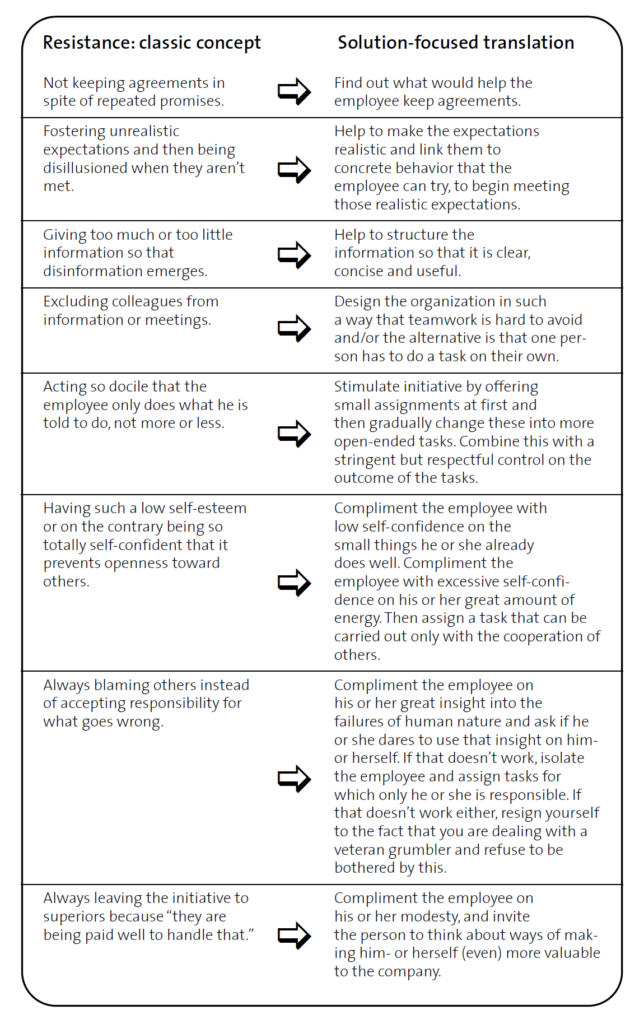Question number 6: How do I manage my employees?
A little note on the concept of resistance

Resistance is a peculiar form of cooperation.
How often do you hear: “I would like to … but no one will support me” or “If it were up to me, that would have been finished a long time ago but the others don’t want to …” or “The top/middle/lower management isn’t prepared to accept my proposals, so there is nothing I can do” or “They are against me” or “There are too many opposing forces” or “If that wasn’t the case, I would …”.
When they don’t achieve their goals, some people even use the concept of resistance as an explanation: something or someone else is the cause of their failure. Furthermore, it is not their failure, they are not to blame. It is someone else’s fault. “Well, it wasn’t possible anyway. The odds were stacked against us.”
We often have to work with people who don’t ask for our help, don’t allow us to help them, or sometimes openly oppose our offer of help. All the above-mentioned attitudes and behavior styles are called resistance to change, in the classical problem-oriented approach. Resistance is seen as a negative characteristic of a person — as if people prefer not to change or refuse to acknowledge the possibility of change.
When we meet resistance, we are tempted to keep repeating our viewpoint in other words. If we don’t watch ourselves, we get excited and annoyed. We might even become angry. But reacting with anger won’t help us to reach a solution — in fact, it will probably make things worse.
To summarize, in the classical problem-oriented management style, resistance is seen as “a thing, a virus” that exists in the world. In the solution-focused view, resistance is merely a concept in the mind of the one who defines certain behavior as resistance: it has no “objective truth” whatsoever.
Steve de Shazer showed that resistance in the classical interpretation is just a concept, not more, not less, and in addition to that a rather useless concept. The solution-focused model takes an entirely different stance on this topic. It defines resistance as “every interaction that initially doesn’t seem useful for achieving the goals, but that nevertheless offers information.” The word “seem” is crucial in this definition because it indicates that one can do something else with this information rather than just discarding it as negative.
If resistance is no longer seen as opposition, then we do not have to oppose it. Instead, if resistance is seen as information about a peculiar form of cooperation, it becomes a useful concept. Resistance is no longer a dragon to be slain. Resistance is a signpost guiding our behavior.
When you offer your best advice to someone who doesn’t ask you for advice, it shouldn’t come as a surprise that that person doesn’t listen, let alone follow your advice. Is that a resistant person? Or is his behavior of not accepting your advice his way of informing you about your less than appropriate action?
Seeing resistance as useful information isn’t easy. Learning this novel and innovative view of the concept of resistance will make you into a master of cooperation!

Beware of corporate sabotage
Some forms of resistance can’t be seen, let alone tolerated as information: insubordination, sabotage, deliberate and excessive criticism, (sexual and other) harassment, theft and other criminal actions, etc. Such acts of “corporate terrorism” are unacceptable, and swift action must be taken. Treating people in a respectful way does not mean that everything is allowed.
In cases of corporate sabotage, you will take off your manager-coach hat and put on the hat of the manager-leader who is also responsible for keeping good order. Of course, you will first make dead sure that you are not making a wrong judgment about the behavior of the employee concerned. You will probably consult with others about the issue. But once you are one hundred percent sure that their behavior is deliberately geared to doing harm to their fellow employees and/or the company, you will take action to remove these people from the payroll. The best removals are swift removals. And it is always good to inform the remaining employees about the facts behind this removal so that nobody is left in the dark. This sets a good example for everybody and, at the same time, it allows you to show your respect to the employees who are loyal to the company.

 LOUISCAUFFMAN.COM
LOUISCAUFFMAN.COM